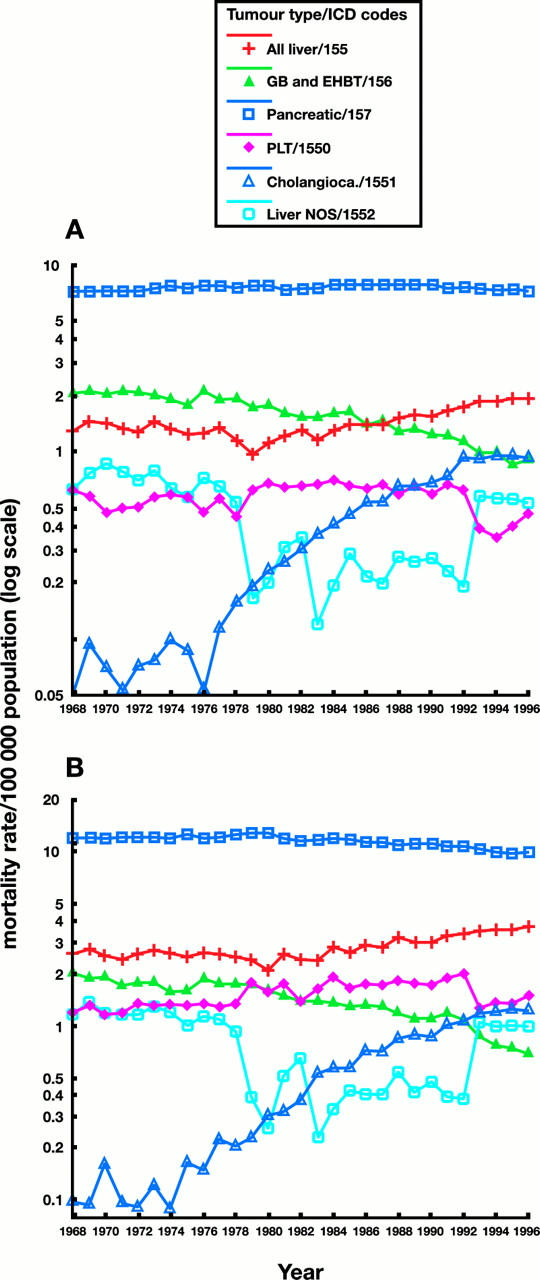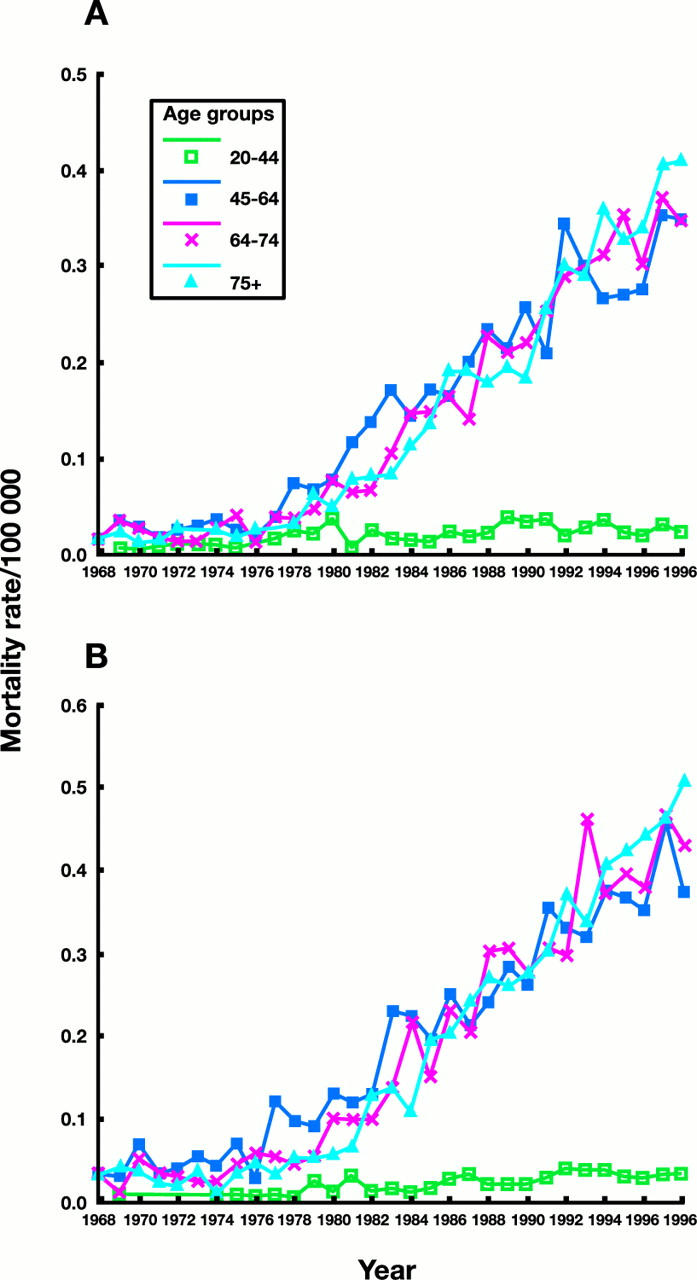Abstract
BACKGROUND—The age standardised mortality rate per 100 000 population for all causes of liver tumours (International Classification of Disease 9 (ICD-9) 155) has almost doubled in England and Wales during the period 1979-1996. We further analysed the mortality statistics to determine which anatomical subcategories were involved. METHODS—Mortality statistics for liver tumours of ICD-9 155, 156, and subcategories, and for tumours of the pancreas (ICD-9 157), in England and Wales were investigated from the Office for National Statistics, London, from 1968 to 1996 inclusive. Data for 1997 and 1998 were also available on intrahepatic cholangiocarcinomas. RESULTS—There has been a marked rise in age standardised mortality rates for intrahepatic cholangiocarcinoma. Since 1993, it represents the commonest recorded cause of liver tumour related death in England and Wales. This is evident in age groups older than 45 years. In contrast, mortality trends from other primary liver tumours, including hepatocellular carcinoma, were unremarkable. CONCLUSIONS—The observed increase in mortality from intrahepatic cholangiocarcinoma may represent better case ascertainment and diagnosis due to improved diagnostic imaging, use of image guided biopsies, or increased use of ERCP. However, the trend started before ERCP was introduced nationally, mortality rates have continued to increase steadily thereafter, and there is no clear evidence that diagnostic transfers easily explains the findings. Alternatively, these observations may represent a true increase in intrahepatic bile duct tumours. Epidemiological studies are required to determine whether there is any geographical clustering of cases around the UK. Keywords: intrahepatic cholangiocarcinoma; age standardised mortality rates; age specific mortality rates
Full Text
The Full Text of this article is available as a PDF (192.6 KB).
Figure 1 .

Age standardised mortality rates per 100 000 population of England and Wales in (A) females and (B) males for: all malignant liver tumours (ICD-9 155); primary tumours of the hepatic parenchyma which are mainly hepatocellular carcinomas (ICD-9 1550); intrahepatic cholangiocarcinoma (ICD-9 1551); unspecified liver tumours (ICD-9 1552); all tumours of the gall bladder and extrahepatic biliary tree (ICD-9 156); and all tumours of the pancreas (ICD-9 157). Mortality rates are plotted on a logarithmic scale. All liver, all malignant liver tumours; GB and EHBT, gall bladder and extrahepatic biliary tree; PLT, primary liver tumours—mainly hepatocellular carcinoma; cholangioca., intrahepatic cholangiocarcinoma; liver NOS, liver, not otherwise specified.
Figure 2 .

Age specific mortality rates per 100 000 population of England and Wales in (A) females and (B) males for intrahepatic cholangiocarcinoma (ICD-9 155.1).
Selected References
These references are in PubMed. This may not be the complete list of references from this article.
- Chen C. J., Yu M. W., Liaw Y. F. Epidemiological characteristics and risk factors of hepatocellular carcinoma. J Gastroenterol Hepatol. 1997 Oct;12(9-10):S294–S308. doi: 10.1111/j.1440-1746.1997.tb00513.x. [DOI] [PubMed] [Google Scholar]
- Cotton P. B. ERCP. Gut. 1977 Apr;18(4):316–341. doi: 10.1136/gut.18.4.316. [DOI] [PMC free article] [PubMed] [Google Scholar]
- El-Serag H. B., Mason A. C. Rising incidence of hepatocellular carcinoma in the United States. N Engl J Med. 1999 Mar 11;340(10):745–750. doi: 10.1056/NEJM199903113401001. [DOI] [PubMed] [Google Scholar]
- Ellis E. F., Gordon P. R., Gottlieb L. S. Oral contraceptives and cholangiocarcinoma. Lancet. 1978 Jan 28;1(8057):207–207. doi: 10.1016/s0140-6736(78)90640-2. [DOI] [PubMed] [Google Scholar]
- Fabrikant J. I. The kinetics of cellular proliferation in regenerating liver. J Cell Biol. 1968 Mar;36(3):551–565. doi: 10.1083/jcb.36.3.551. [DOI] [PMC free article] [PubMed] [Google Scholar]
- Forman D., Vincent T. J., Doll R. Cancer of the liver and the use of oral contraceptives. Br Med J (Clin Res Ed) 1986 May 24;292(6532):1357–1361. doi: 10.1136/bmj.292.6532.1357. [DOI] [PMC free article] [PubMed] [Google Scholar]
- Haydon G. H., Hayes P. C. Screening for hepatocellular carcinoma. Eur J Gastroenterol Hepatol. 1996 Sep;8(9):856–860. [PubMed] [Google Scholar]
- Littlewood E. R., Barrison I. G., Murray-Lyon I. M., Paradinas F. J. Cholangiocarcinoma and oral contraceptives. Lancet. 1980 Feb 9;1(8163):310–311. doi: 10.1016/s0140-6736(80)90804-1. [DOI] [PubMed] [Google Scholar]
- Ludwig J., Ritman E. L., LaRusso N. F., Sheedy P. F., Zumpe G. Anatomy of the human biliary system studied by quantitative computer-aided three-dimensional imaging techniques. Hepatology. 1998 Apr;27(4):893–899. doi: 10.1002/hep.510270401. [DOI] [PubMed] [Google Scholar]
- McCune W. S. ERCP--the first twenty years. Gastrointest Endosc. 1988 May-Jun;34(3):277–278. doi: 10.1016/s0016-5107(88)71331-0. [DOI] [PubMed] [Google Scholar]
- Mitacek E. J., Brunnemann K. D., Hoffmann D., Limsila T., Suttajit M., Martin N., Caplan L. S. Volatile nitrosamines and tobacco-specific nitrosamines in the smoke of Thai cigarettes: a risk factor for lung cancer and a suspected risk factor for liver cancer in Thailand. Carcinogenesis. 1999 Jan;20(1):133–137. doi: 10.1093/carcin/20.1.133. [DOI] [PubMed] [Google Scholar]
- Nousbaum J. B., Pol S., Nalpas B., Landais P., Berthelot P., Bréchot C. Hepatitis C virus type 1b (II) infection in France and Italy. Collaborative Study Group. Ann Intern Med. 1995 Feb 1;122(3):161–168. doi: 10.7326/0003-4819-122-3-199502010-00001. [DOI] [PubMed] [Google Scholar]
- Rosenberg L. The risk of liver neoplasia in relation to combined oral contraceptive use. Contraception. 1991 Jun;43(6):643–652. doi: 10.1016/0010-7824(91)90007-3. [DOI] [PubMed] [Google Scholar]
- Rubel L. R., Ishak K. G. Thorotrast-associated cholangiocarcinoma: an epidemiologic and clinicopathologic study. Cancer. 1982 Oct 1;50(7):1408–1415. doi: 10.1002/1097-0142(19821001)50:7<1408::aid-cncr2820500728>3.0.co;2-t. [DOI] [PubMed] [Google Scholar]
- Sorensen H. T., Friis S., Olsen J. H., Thulstrup A. M., Mellemkjaer L., Linet M., Trichopoulos D., Vilstrup H., Olsen J. Risk of liver and other types of cancer in patients with cirrhosis: a nationwide cohort study in Denmark. Hepatology. 1998 Oct;28(4):921–925. doi: 10.1002/hep.510280404. [DOI] [PubMed] [Google Scholar]
- Taylor-Robinson S. D., Foster G. R., Arora S., Hargreaves S., Thomas H. C. Increase in primary liver cancer in the UK, 1979-94. Lancet. 1997 Oct 18;350(9085):1142–1143. doi: 10.1016/S0140-6736(05)63789-0. [DOI] [PubMed] [Google Scholar]
- Thuluvath P. J., Rai R., Venbrux A. C., Yeo C. J. Cholangiocarcinoma: a review. Gastroenterologist. 1997 Dec;5(4):306–315. [PubMed] [Google Scholar]


